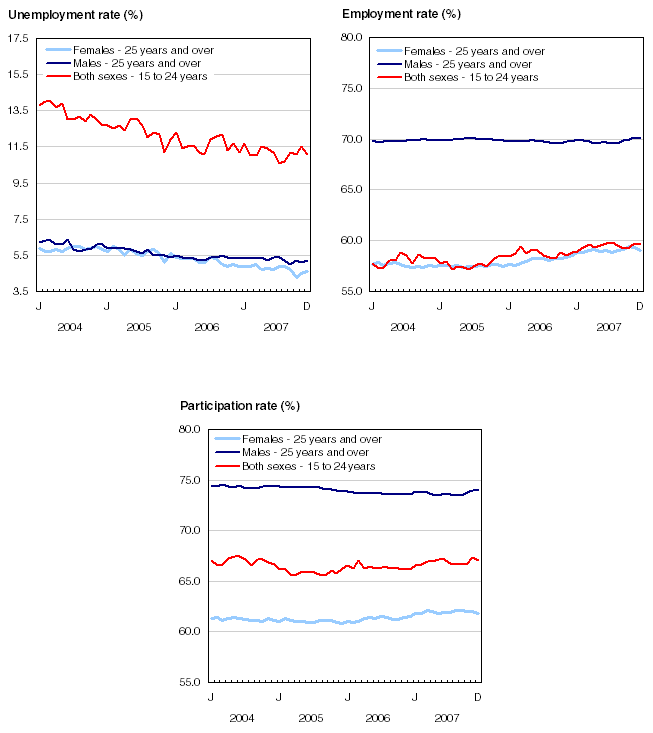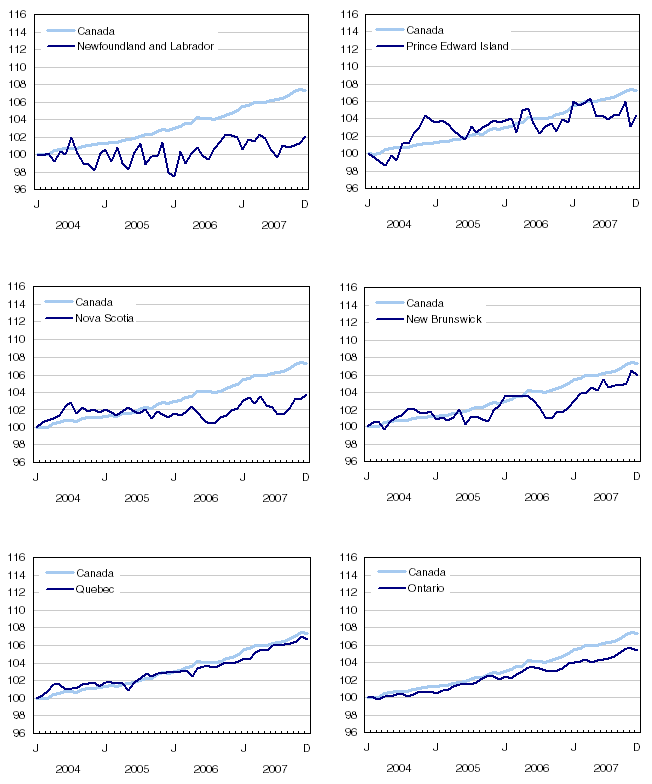Common menu bar links
Not for release before 7 A.M. E.S.T. Friday, January 11, 2008
December 2 to 8, 2007
Archived Content
Information identified as archived is provided for reference, research or recordkeeping purposes. It is not subject to the Government of Canada Web Standards and has not been altered or updated since it was archived. Please "contact us" to request a format other than those available.
Analysis — December 2007
Following seven consecutive months of increases, employment edged down in December (-19,000). Over the year, however, employment was up an estimated 2.2% (+370,000), similar to the growth rate of 2006 (+2.1%) and the fifteenth consecutive year of employment growth. The unemployment rate held steady at 5.9% in December.
Full-time employment accounted for three-quarters of Canada’s employment growth in 2007. Although older workers represented 30% of the working age population, they accounted for half of the total employment growth.
For the second straight year, Alberta charted the highest employment growth rate of all provinces, although at a slower clip than in 2006. Employment gains were also strong in New Brunswick, British Columbia and Quebec in 2007.
Alberta posted the only significant employment gain in December (+21,000). This, however, was offset by declines in six provinces.
Manufacturing experienced another drop in December (-33,000). Following a decline of 2.4% in 2006, employment in this industry was further reduced by an estimated 6.2% in 2007.
All of the employment losses in December were among employees in the private sector, leaving gains for this group of workers up a tepid 0.4% over the course of the year. Gains for the year were mostly in the public sector and self-employment.
Wages continued to rise in December, increasing to 4.9% year-over-year, exceeding the most recent increase in the Consumer Price Index of 2.5%. At $23.50, Alberta’s average hourly wage stood well above that of other provinces, up 8.8% or close to two dollars from 12 months earlier, and far above that province’s Consumer Price Index change of 4.7%.
Canada’s employment gains surpassed that of the United States
Canada’s employment growth of 2.2% in the past twelve months far surpassed that of the United States (+0.2%). Employment gains in the service-producing sector in the United States were hampered by continued losses in manufacturing as well as declines in construction and financial activities in 2007.
The Canadian unemployment rate has historically been higher than that of the United States, even once adjusted to US concepts. From 2001 to 2006, the average gap was approximately 1.0 percentage point. While the Canadian unemployment rate reached record lows in 2007, the US unemployment rate increased, narrowing the gap between the two rates to 0.3 percentage points in December 2007. Meanwhile, employment and participation rates in Canada remained above those in the United States throughout 2007.
Goods-producing sector employment hindered by manufacturing
In December, employment was down in the goods-producing sector, as declines in manufacturing and agriculture were only partly offset by increases in natural resources and construction.
In 2007, the goods-producing sector declined by 1.2% (-48,000), despite strength in construction and utilities.
With a surge in the Canadian dollar, soaring costs for energy and other materials and stiff competition from other countries, the manufacturing industry suffered considerable employment losses in 2007. Employment in this industry shrank by an estimated 132,000 (-6.2%), bringing total accumulated losses since November 2002 to 348,000 (-14.9%), approaching the early 1990s manufacturing decline of 364,000 (-17.1%). Over the year, manufacturing losses mainly stemmed from wood product manufacturing; motor vehicle and parts; fabricated metal and furniture.
Building on the momentum of the previous five years, employment in construction continued to grow in 2007 (+6.8%). Employment growth in utilities (+13.0%) in 2007, a more recent trend, brings employment in this industry to similar levels as those in the early 1990s.
Lion’s share of growth in the service-producing sector in 2007
In December, there were a number of industry changes in the service-producing sector compared to the previous month, as increases in transportation and warehousing and public administration were offset by declines in accommodation and food services and ‘other services’.
Employment in the service-producing sector rose an estimated 3.3% (+417,000) in 2007. Above-average gains occurred in public administration (+9.4%); information, culture and recreation (+8.9%); professional, scientific and technical services (+5.7%); transportation and warehousing (+4.8%) and ‘other services’ (+4.8%).
Public sector and self-employment fuelled employment growth over the year
Despite little change in December, public sector employment rose by 6.5% (+208,000) since December 2006. Growth was particularly strong in public administration; utilities; health and social assistance; and education.
Self-employment rose by an estimated 22,000 in December, bringing growth in 2007 to 4.5% (+114,000). This is in contrast to 2006 when it edged down (-0.4%). All of the self-employment gains were in full-time work in 2007.
In December, employment in the private sector declined by 51,000, offsetting the gains made the previous month. Over the year, private sector employment notched up only 0.4% (+47,000), driven by part-time work.
The two westernmost provinces continued to thrive in 2007
Employment in Alberta surged ahead in December (+21,000), bringing this province’s employment rate to another record high (71.9%), while the unemployment rate dipped 0.4 percentage points to 3.2%.
Alberta’s employment for the year rose by a solid 4.3%, the highest growth rate of all provinces. This was, however, lower than the robust growth seen in 2006 (+5.6%), when employment gains for this province were the highest since the previous oil boom in the mid-to-late seventies. Gains over the year stemmed from full-time employment, primarily in natural resources, construction and a number of service-producing industries.
Although employment was down in British Columbia in December, this province had strong employment growth in 2007 (+3.3%). With a mix of full- and part-time gains, employment was particularly strong over the year in the goods-producing sector (+4.1%): with gains in construction; utilities; natural resources and agriculture, as well as a few service industries: information, culture and recreation; transportation and warehousing; public administration and trade.
With fewer people employed in Manitoba in December, the employment rate declined to 66.3%, following a record high in November of 67.0%. The province’s 2007 employment growth rate of 1.9% (+11,000) is the highest since 2002.
In December, employment was also down in Saskatchewan. Following strong growth in 2006 (+4.9%), employment growth in 2007 was only 0.3%. Weakness in agriculture and trade offset gains in other industries. Despite little employment growth in 2007, Saskatchewan’s December unemployment rate of 4.0% was the second lowest of all provinces.
Quebec’s employment situation improved in 2007
Although employment edged down in December, Quebec’s employment growth was stronger in 2007 than in 2006. This province’s growth rate was above the national average, at 2.4%, the best in five years, as employment rates reached record highs in 2007 (61.4% in November) and the unemployment rate hit a 33-year low (6.9% first reached in June). However, employment gains were mostly in part-time work.
Quebec’s employment gains over the year were in construction; utilities; accommodation and food services; and ‘other services’. Manufacturing declines were substantial at an estimated 43,000 (-7.5%) in 2007, primarily in the manufacturing of textile and clothing; food; wood and printing products.
Employment in Ontario also edged down in December, as losses in manufacturing; accommodation and food services; and finance, insurance, real estate and leasing were only partially offset by gains in trade and public administration. This brought Ontario’s unemployment rate up 0.3 percentage points to 6.5% in December, 0.6 percentage points above the national average.
Ontario’s employment growth over the year was a tepid 1.4% mainly due to weakness in the goods-producing sector (-5.6%). Not only were there losses in manufacturing, but also in agriculture; natural resources and construction over the year. Manufacturing employment in this province dropped 6.5% (-64,000) in 2007, primarily in motor vehicles, body and parts; fabricated metal; and wood products manufacturing.
Despite these weaknesses in the goods-producing sector in Ontario during 2007, there were notable gains in the services industries (+3.6%): public administration; education; information, culture and recreation; and professional, scientific and technical services. Overall employment growth was all in full-time work in the province.
Great year for New Brunswick
Despite a small decline in employment in December, New Brunswick had the second-highest growth rate of all provinces in 2007 (+3.6%), and is the only Atlantic province to record significant growth. This follows two years of little employment change for New Brunswick.
New Brunswick’s employment gains over the year were in full-time work and primarily in professional, scientific and technical services; health care and social assistance; public administration and construction.
Employment robust for older workers in 2007
Employment increased by an estimated 17,000 for people aged 55 and over in December. Older workers had above-average employment growth in 2007 (+7.7%), with higher gains for older women (+9.4%) than men (+6.4%). Older women were more likely to be participating in the labour market in 2007, as their participation rate increased 1.6 percentage points to 27.9% from one year ago, their highest rate on record.
Youth also experienced healthy employment gains in 2007 (+2.1%), the strongest pace of growth since 2002. In December, 59.6% of those aged 15 to 24 were employed, up 0.8 percentage points from December 2006.
In December, employment fell for women aged 25 to 54 years (-30,000), bringing their employment rate down 0.4 percentage points to 78.1%. Over the year, employment growth was moderate for both men and women in this age group, each up 1.1%.
Annual averages
Another indicator of labour market trends is the annual average, which is an average of the 12 months of the year and is usually compared with the 12-month average of the previous year. Annual averages are more stable and better reflect longer trends than December-over-December estimates. Annual average estimates for 2007 are now available on CANSIM (tables 282-0001 to 282-0099). The following analysis on the territories, Aboriginal peoples living off-reserve and immigrants uses annual averages, due to their small population size.
Nunavut leading territories in employment gains
The ten largest communities of Nunavut recorded an employment increase of 11.0% (+900) between 2006 and 2007, pushing their annual average unemployment rate down to an estimated 8.9% in 2007 (-1.4 percentage points). This was the only territory with employment growth in 2007.
Employment has been stable in both the Northwest Territories and in Yukon in the last few years, however, Yukon’s unemployment rate increased to 5.1% in 2007 from 4.3% in 2006. The unemployment rate for the Northwest Territories has been at 5.4% for the past three years.
Aboriginal people living off-reserve continue to find employment, but at a slower pace
Among the Aboriginal off-reserve population in the four western provinces, employment gains in 2007 were slower (+2.2%) compared to those observed in 2006 (+6.6%) and 2005 (+3.7%). Among non-Aboriginal people in western Canada, employment increased by 3.6%. Aboriginal people living off-reserve in Alberta and Saskatchewan had the strongest employment gains of the four provinces in 2007.
The unemployment rate for off-reserve Aboriginal people in 2007 was 9.4%, a substantial decline from 12.2% in 2005.
Above average employment growth for recent immigrants
In 2006, the Labour Force Survey began asking questions to identify the immigrant population. Very recent immigrants are those who landed in Canada within the previous five years, recent immigrants are those who landed between five and ten years earlier and established immigrants landed in Canada 10 years ago or more.
Results of the annual data show that the employment rate in 2007 for very recent immigrants was stable at 57.5% compared to 2006, whereas recent immigrants experienced an increase of 1.0 percentage point to 66.3% and established immigrants recorded a 0.4 percentage point increase to 56.5%.
Although unemployment rates for very recent immigrants are high at 11.9%, this is a decline of 0.5 percentage points from 2006 due to a decrease in their labour force participation. The unemployment rate of recent immigrants was lower, at 8.2% in 2007, a decline of 0.5 percentage points from 2006. In 2007, established immigrants had the same unemployment rate as those born in Canada, at 5.7%.
Note to readers
The analysis presented in this release describes labour market trends in 2007 by looking at the change in estimates from December 2006 to December 2007. This indicator picks up the more recent labour market trends for the year but can be influenced by unusual spikes or declines in the end points used to calculate the change.
Seasonally adjusted estimates from the Labour Force Survey will be revised using the latest seasonal factors, going back three years (January 2005 onwards). They will be available on CANSIM (tables 282-0087 to 282-0094) February 1st, 2008.
The Labour Force Survey estimates are based on a sample, and are therefore subject to sampling variability. Estimates for smaller geographic areas or industries will have more variability. For an explanation of sampling variability of estimates, and how to use standard errors to assess this variability, consult the Data Quality section in this publication.
The 2006 Labour Force Historical Review on CD-ROM (71F0004XCB, $209) is now available.
| Employment | Change in employment | Unemployment rate | ||||
|---|---|---|---|---|---|---|
| 2006 | 2007 | 2006 to 2007 | 2006 | 2007 | ||
| thousands | thousands | percent | ||||
| Canada | 16,484.3 | 16,866.4 | 382.1 | 2.3 | 6.3 | 6.0 |
| Newfoundland and Labrador | 215.7 | 217.1 | 1.4 | 0.6 | 14.8 | 13.6 |
| Prince Edward Island | 68.6 | 69.3 | 0.7 | 1.0 | 11.0 | 10.3 |
| Nova Scotia | 441.8 | 447.6 | 5.8 | 1.3 | 7.9 | 8.0 |
| New Brunswick | 355.4 | 362.8 | 7.4 | 2.1 | 8.8 | 7.5 |
| Quebec | 3,765.4 | 3,851.7 | 86.3 | 2.3 | 8.0 | 7.2 |
| Ontario | 6,492.7 | 6,593.8 | 101.1 | 1.6 | 6.3 | 6.4 |
| Manitoba | 587.0 | 596.5 | 9.5 | 1.6 | 4.3 | 4.4 |
| Saskatchewan | 491.6 | 501.8 | 10.2 | 2.1 | 4.7 | 4.2 |
| Alberta | 1,870.7 | 1,959.4 | 88.7 | 4.7 | 3.4 | 3.5 |
| British Columbia | 2,195.5 | 2,266.3 | 70.8 | 3.2 | 4.8 | 4.2 |
| Yukon Territory | 15.5 | 15.0 | -0.5 | -3.2 | 4.3 | 5.1 |
| Northwest Territories | 22.8 | 22.6 | -0.2 | -0.9 | 5.4 | 5.4 |
| Nunavut - 10 largest communities | 8.2 | 9.1 | 0.9 | 11.0 | 10.3 | 8.9 |









